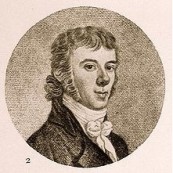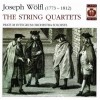Biography
Joseph Johann Baptist Woelfl (German spelling:) Joseph Wölfl (24 December 1773 - 21 May 1812) was an Austrian pianist and composer.
Woelfl was born at Salzburg, where he studied music under Leopold Mozart and Michael Haydn.
He first appeared in public as a soloist on the violin at the age of seven. Moving to Vienna in 1790 he visited Wolfgang Mozart and may have taken lessons from him. His first opera, Der Höllenberg, appeared there in 1795.
Woelfl was very tall (over 6 feet), and with an enormous finger span (his hand could strike a thirteenth, according to his contemporary Frantisek Tomasek); to his wide grasp of the keyboard he owed a facility of execution which he turned to good account, especially in his extempore performances.
Although he dedicated his 1798 sonatas op. 6 to Beethoven, the two were rivals. Beethoven however bested Woelfl in a piano 'duel' at the house of Count Wetzlar in 1799, after which Woelfl's local popularity waned.[1] After spending the years 1801 -1805 in Paris, Woelfl moved to London, where his first concert performance was on 27 May 1805.
In England, he enjoyed commercial if not critical success. In 1808 he published his Sonata, Op. 41, which, on account of its technical difficulty, he entitled Non Plus Ultra; and, in reply to the challenge, a sonata by Dussek, originally called Le Retour à Paris, was reprinted with the title Plus Ultra, and an ironic dedication to Non Plus Ultra. He also completed for publication an unfinished sonata of George Pinto.
Woelfl died in Great Marylebone Street, London, on 21 May 1812.
Woelfl's works have long disappeared from the concert repertory. However, in 2003 four selected piano sonatas of his (Op. 25 and Op. 33) were recorded by the pianist Jon Nakamatsu (Harmonia Mundi CD # 907324). (An Adda CD in 1988 contained his three opus 28 sonatas, played by Laure Colladant, who also recorded the sonatas opus 6 for Adès in 1993 and the three opus 33 sonatas for the label Mandala in 1995.)
In 2006, German pianist Yorck Kronenberg recorded Woelfl's piano concertos 1, 5 and 6 in addition to a movement from the piano concerto 4.[2] The piano concertos closely resemble the later piano concertos of Mozart, who had pioneered the genre; they can be distinguished from Mozart's works by the larger range of the piano, which had been extended shortly after Mozart's death.







